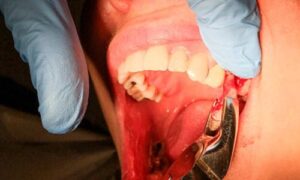Introduction
Root canal treatment is a dental procedure to alleviate severe tooth pain and save a damaged or infected tooth. It involves removing the infected pulp from the tooth’s interior and sealing it to prevent further damage. However, determining whether you require a root canal treatment can be challenging without professional guidance. This article will explore the signs, symptoms, and diagnostic methods dentists use to determine if a root canal treatment is necessary.
Prevalence of Root Canal Treatment:
Root canal treatment is a standard dental procedure, with millions of root canals performed worldwide each year. According to the American Association of Endodontists, dentists in the United States alone perform approximately 15 million root canal treatments annually.
Understanding the Anatomy of a Tooth
To comprehend the need for a root canal treatment, it’s essential to understand the structure of a tooth. The outer layer, called the enamel, covers the dentin, which surrounds the tooth’s pulp. The pulp contains nerves, blood vessels, and connective tissues. When the pulp becomes inflamed or infected, it can lead to severe pain and potential tooth loss if left untreated.
Common Signs and Symptoms
Several signs and symptoms indicate the need for a root canal treatment. While only a professional dentist can provide a definitive diagnosis, these indicators can help you identify potential problems:
a. Persistent Toothache: Intense, lingering tooth pain, especially when chewing or applying pressure, may indicate an infected tooth pulp.
b. Sensitivity to Temperature Changes: If consuming hot or cold food and drinks causes sharp, prolonged sensitivity, it could indicate pulp inflammation or infection.
c. Gum Swelling and Tenderness: Swollen or tender gums near the affected tooth can indicate an underlying infection.
d. Discoloration and Darkening: Discoloration or darkening of the tooth may indicate that the pulp inside is compromised.
e. Persistent Pimple on the Gums: A small pimple-like bump on the gums near the affected tooth can indicate a dental abscess requiring immediate attention.
Additional Indicators
Apart from the typical signs mentioned above, there are other indications that you may require a root canal treatment:
a. Cracked or Chipped Tooth: If a tooth is fractured, cracked, or chipped, it can expose the pulp to bacteria, leading to infection and inflammation.
b. Lingering Sensitivity: Prolonged sensitivity to sweet or acidic foods and beverages may indicate the need for a root canal.
c. Loose Tooth: A loose tooth, especially without trauma, can suggest underlying root damage and infection.
d. Bad Taste or Odor: An unpleasant taste or odor from the affected tooth can indicate an infection.
Diagnostic Methods
To confirm the need for a root canal treatment, your dentist will perform various diagnostic procedures, including:
a. Dental Examination: A thorough examination of your teeth, gums, and oral tissues will help identify any visible signs of infection or damage.
b. X-rays: Dental X-rays provide a detailed view of the tooth’s roots and surrounding structures, enabling the dentist to identify signs of infection or decay.
c. Pulp Testing: Pulp vitality tests, such as hot and cold sensitivity tests, electric pulp testing, or laser Doppler flowmetry, can help determine the health of the tooth’s pulp.
d. Percussion Testing: The dentist can assess pain or discomfort by tapping the tooth, indicating pulp inflammation or infection.
Risk Factors for Root Canal Treatment
Certain factors increase the likelihood of needing a root canal treatment. Discussing these risk factors can help readers understand the importance of proactive dental care.
a. Deep Tooth Decay: Extensive tooth decay that reaches the pulp increases the chances of pulp infection and the need for a root canal.
b. Dental Trauma: Teeth with significant trauma, such as fractures or dislodgment, are susceptible to pulp damage and infection.
c. Previous Dental Procedures: Teeth that have undergone multiple dental procedures, such as fillings or crowns, may develop complications over time, leading to root canal treatment.
d. Dental Abscess: An untreated dental abscess, a pocket of pus caused by an infection, may require root canal therapy to eliminate the disease and save the tooth.
Importance of Timely Treatment
Promptly addressing the need for a root canal treatment is vital to prevent further complications. This section highlights the potential consequences of delaying treatment, emphasizing the significance of timely intervention.
a. Spread of Infection: An untreated infected tooth can allow the infection to spread to neighboring teeth, gums, and even the jawbone, leading to more extensive oral health issues.
b. Abscess Formation: Prolonged infection can result in the development of a dental abscess, a painful condition that requires immediate attention and treatment.
c. Tooth Loss: If left untreated, an infected tooth may eventually require extraction, leading to the loss of a natural tooth and the need for more invasive dental procedures, such as dental implants or bridges.
The World Health Organization (WHO) estimates that nearly 100% of adults worldwide have experienced dental cavities at some point in their lives, increasing the likelihood of needing root canal treatment.
Alternatives to Root Canal Treatment
Sometimes, alternative treatment options may be available depending on the specific dental condition. This section provides an overview of alternative treatments that may be considered.
a. Antibiotics and Pain Management: For mild cases of tooth infection or inflammation, antibiotics and pain management medication may be prescribed to alleviate symptoms temporarily.
b. Tooth Extraction: In situations where the tooth is severely damaged, or the infection is too advanced, extraction may be necessary. The extracted tooth can be replaced with a dental implant, bridge, or partial denture.
c. Pulp Capping: In some instances where the infection has not reached the tooth’s pulp, a dental procedure called pulp capping may be performed to preserve the vitality of the tooth without the need for a root canal treatment.
Conclusion
Recognizing the signs and symptoms that may indicate the need for a root canal is crucial for seeking timely dental intervention. Persistent tooth pain, sensitivity, gum swelling, discoloration, and a pimple on the gums are all potential indicators of infected tooth pulp. Additionally, cracked teeth, loose teeth, lingering sensitivity, and bad taste or odor can also suggest the need for a root canal treatment. However, only a qualified dentist can provide a definitive diagnosis through a comprehensive examination, X-rays, and other diagnostic tests. If you experience any of these symptoms, scheduling an appointment with a dental professional to evaluate your oral health and determine the appropriate course of action is crucial. That may include root canal treatment to restore your dental health.














